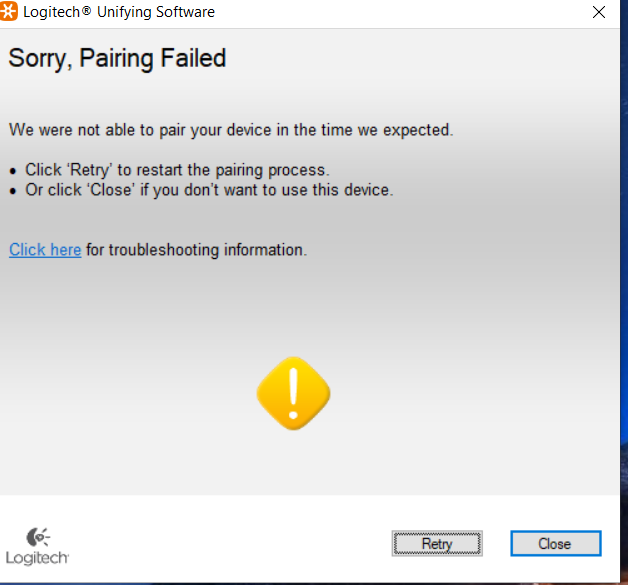
- #LOGITECH UNIFYING SOFTWARE PAIRING FAILED HOW TO#
- #LOGITECH UNIFYING SOFTWARE PAIRING FAILED WINDOWS 10#
- #LOGITECH UNIFYING SOFTWARE PAIRING FAILED PRO#
- #LOGITECH UNIFYING SOFTWARE PAIRING FAILED SOFTWARE#
- #LOGITECH UNIFYING SOFTWARE PAIRING FAILED PC#
With this setup, the devices behave more like “wired” devices. It’s a good idea to mark the receivers so that you know which one is which: in my case, I bought the mouse before Logitech had the big bad Logo Redesign idea, so both my mouse and its receiver have the old Logitech logo, and the keyboard and its receiver have the new logo. They keyboard is at all times unaffected and can also be unplugged – for use with another computer. I can now unplug the mouse receiver and use it in my Mac, and when I’m done I can plug it back into the Windows machine and use the mouse there. Now each device is paired to its own receiver again.
#LOGITECH UNIFYING SOFTWARE PAIRING FAILED SOFTWARE#

And while I was waiting for the agent to reply, I tried the following. With nowhere else to turn, I contacted Logitech Chat Support. What a bummer! The Solution: Un-pairing those devices again Always good to have that in place! I launched the Logitech software and followed the instructions… but none of the two USB receivers were detected. Lucky for me, I had setup a VNC connection to my Z600, so I just logged in from my Mac and at least got control of Windows that way. I couldn’t access the Windows machine anymore either – so how was I going to start the Logitech software to repair this mess? The light on the mouse still came on, but the light on the keyboard (usually comes on when you press CAPS LOCK) was also dead. It was as if I had two dead devices on my desk. So I plugged the mouse USB receiver into the Windows machine too, and now NOTHING was working anymore – neither in Windows nor on Mac. The trouble was the keyboard was no longer detected on the Windows machine. And even when I switched on my Windows PC, the mouse was still working on the Mac. I was happy, modelling things in Blender (which is a little cumbersome with a Mac trackpad, or perhaps I’m just not used to it anymore).
#LOGITECH UNIFYING SOFTWARE PAIRING FAILED PC#
The good news was that when I used the original mouse receiver on my Mac, with my Windows PC switched off, everything worked just fine.
#LOGITECH UNIFYING SOFTWARE PAIRING FAILED HOW TO#
So now I had to figure out how to UN-pair both devices again and put them back to how things used to be (before I started messing with them). I regretted pairing both devices to the same receiver and wished I hadn’t done that, for this very eventuality. But really, there’s only so much space on my desk, and I really don’t need more clutter in front of me for just an occasional switch.

I know, it’s exotic, and perhaps I should have just bought another mouse.
#LOGITECH UNIFYING SOFTWARE PAIRING FAILED WINDOWS 10#
It all worked fine on my Windows 10 machine, until I wanted to use the mouse (not the keyboard) with my Mac. Turns out it was relatively easy to pair both devices to the same receiver, thanks to a small piece of software that can be found here, along with instructions on how to use it: Being an all-efficient belt-and-braces kinda guy, I tried my luck. Apparently you can connect up to 6 devices to one receiver and store any spare ones inside the mouse or keyboard. However, I heard great things about these little receivers and wanted to free up a USB port, and thought I’d connect both devices to the same receiver. I could plug both receivers in, and both devices would work great. I also had a Logitech M325 mouse, both of which came with Unifying USB receivers.

At the same time, the paranoid systems guy in me didn't like the idea that the Logitech Unifying Receiver (a small USB dongle) still listened for the K780, which meant that, if the keyboard got too close, a stray keypress intended for one machine might be interpreted by another.I’ve recently bought a new Logitech K360 keyboard for my HP Z600 workstation. The perfectionist in me didn't like the idea that the product, which wasn't attached to my development machine, showed as attached. It's a cool hack.Īlthough the K780 is no longer in use on my coding box, Logitech Options insisted it was in use.
#LOGITECH UNIFYING SOFTWARE PAIRING FAILED PRO#
The K780 has a slot designed to hold an iPad, but that slot works equally well holding a trackpad, which allows me to navigate the Final Cut Pro X timeline without taking my hands off the keyboard. That keyboard has since migrated upstairs to my video editing machine. One fix that was eluding me for a while was how to remove a keyboard entry from Logitech Options, the little utility program that helps customize buttons and controls on Logitech devices.Īt some point in the distant past, I had a Logitech K780 keyboard attached to my development machine.


 0 kommentar(er)
0 kommentar(er)
